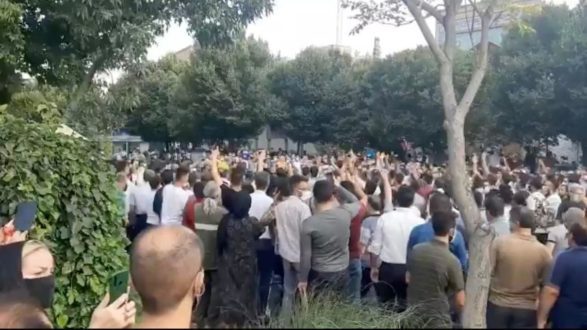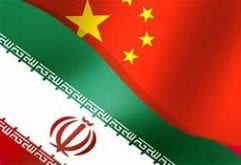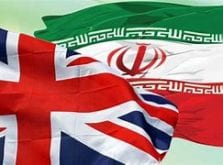gatestoneinstitute.org – Iranian workers… have launched a series of strikes and sit-ins to protest what they regard as “systemic exploitation.”
By the time of this writing, over 100,000 workers were on strike in 122 businesses in 35 cities, relatively small numbers yet significant for two reasons: the protests seem to be spreading and the strikes begin to affect the nerve-centers of the economy including the vital energy industry.
“What we see is the first hissings of the coming explosion.” — Jawad Zar’e, who monitors the Iranian workers’ movement.
Rahmatallah Partovi, head of the Islamic Workers’ Council claims that over 70 percent of Iranian workers live below the official “poverty line”. Alireza Mahjub, a member of the Islamic Majlis (ersatz parliament) puts the figure at 90 percent.
If you listen closely you may hear the time bomb that is ticking in work-place across Iran: tick-tack, icky-tack!

Having retreated in the battle over mandatory hijab, the Islamic Republic leadership in Tehran may be facing a potentially far more dangerous challenge to its hold on power. The challenge comes from Iranian workers who have launched a series of strikes and sit-ins to protest what they regard as “systemic exploitation.”
By the time of this writing, over 100,000 workers were on strike in 122 businesses in 35 cities, relatively small numbers yet significant for two reasons: the protests seem to be spreading and the strikes begin to affect the nerve-centers of the economy including the vital energy industry.
“The sleeping volcano may be waking up,” says Jawad Zar’e who monitors the Iranian workers’ movement. “What we see is the first hissings of the coming explosion.”
In her seminal essay in 2015, researcher Shokuh Mirzadehgi wondered why Iranian workers “put up with their condition with such patience.” Is that patience wearing off? It is too early to tell. What is certain is that the patience mentioned above is running out.
Rahmatallah Partovi, head of the Islamic Workers’ Council, claims that over 70 percent of Iranian workers live below the official “poverty line”. Alireza Mahjub, a member of the Islamic Majlis (ersatz parliament) puts the figure at 90 percent. What is certain is that according to the International Labor Organization (ILO), Iran ranks 160th among all UN member states for average wages, even behind Sudan, Mali, Gambia, and Afghanistan (before the return of the Taliban.) In 2022, Iranian wages averaged $75 a month. With the official inflation rate now topping 50 percent, the average purchasing power of those wages has declined further.
Ironically, Iranian mythology casts Kaweh, an ironsmith and thus representing the working people, as the national hero who leads the national uprising against the usurper despot Zahhak to restore Fereidoun, heir to the Persian throne as king. Kaweh’s apron, made of leather, is supposed to have become mythical Iran’s national flag for at least a generation.
Today’s Kaweh has more mundane concerns. To start with, they want the pre-revolution Labor Code restored.
Based on ILO rules, that code offered Iranian workers a progressive framework that recognized their dignity and gave them the right to form trade unions and to withdraw their labor in protest. It also fixed the working day and week, offered weekly and annual holidays, and ensured unemployment benefits and pensions. More importantly, it made working contracts mandatory with emphasis on long-term contracts, and short-term employment limited to a few specific cases, notably in small businesses. Today, however, according to Fathallah Bayat of the Islamic House of Workers, almost 90 percent of wage-earners are on short-term contracts or with no contracts at all. Short-term contracts could deprive those concerned of legal holidays, safety rules, unemployment benefits, and pensions.
The next demand right now is to calculate all wages in the US dollars as a buffer against inflation. The official wage increases announced annually are in the local currency, the rial, and are wiped out by inflation even before they come into effect. The third demand is to restore the legal right to strike, which was specifically canceled in the 1987 Islamic Labor Law, which also forbade the creation of independent trade unions and workers’ participation in political demonstrations and protests. Thus the fourth demand is to regain the right of forming independent trade unions and organizing protests in defense of the workers’ legitimate demands. The fifth demand is the restoration of pre-revolution rules on the safety of the workplace and mechanisms needed to reduce working accidents.
Today, according to the Islamic Ministry of Labor, over 12,000 “serious workplace accidents causing major injuries or deaths” occur each year. In 2019, 718 workers lost their lives as a result of workplace accidents and 2,080 others were disabled.
The sixth demand is to withdraw the official clerics who are attached to every workplace employing more than 50 people and to disband the strike-breaking units under their control. The clerics insist on workers attending Friday prayers, thus depriving them of part of their only weekly day off. The Islamic authorities employ specially trained strike-breakers known as Construction Jihad, reinforced by paramilitary Baseej (“mobilization”) units when and if needed.
Ironically, in 1922 Iran was the first Asian country to promulgate a Labor Code and fix an 8-hour working day and a day off per week. In 1929, Iran established an unemployment and retirement fund, first applied to elite oil workers. In 1934, a National Labor Office was established, developing into a Ministry of Labor in 1944 with a seat in the Council of Ministers.
Official Tehran propaganda claims that “mercenary leftist groups” linked to the American “Great Satan” and the “Zionist enemy” are behind the current wave of strikes. Tehran Prayer Leader Ayatollah Ahmad Khatami claims that “the godless left” wants to deceive workers and deprive them of the “benefits of Islamic working rules.”
That workers’ rights are somehow a leftist value is a common claim of all despotic regimes of left and right. The fact, however, it was Disraeli’s Conservative government in Great Britain that allowed the first trade unions in the world to be formed. The first pro-labor laws in Tsarist Russia were enacted in 1912 and canceled by the Bolsheviks in 1920.
Thanks to the “benefits of Islamic working rules”, Iranian workers have lost much of what they had gained during Iran’s economic boom years in the 1960s to 1970s. In 1979, just before the mullahs seized power, men and women with working-class backgrounds accounted for 27 percent of the members of the national parliament. Under the mullahs, that has dropped to 8 percent, with mullahs and Islamic Revolutionary Guard Corps figures getting the lion’s share.
According to the Islamic Ministry of Transport and Housing, only 20 percent of Iranian wage-earners own their homes, compared to 44 percent in 1979.
Outside some elite industries, notably energy and military hardware, few Iranian workers benefit from training and/or retraining schemes designed to upgrade their skill and enhance their career prospects. The nationwide scholarship schemes that enabled tens of thousands of children of workers to gain a higher education, including in Western Europe and North America, have all but disappeared. Their place has been taken by scholarships for Lebanese, Iraqi, Yemeni, and, recently, Nigerian and Chinese young men who wish to train as mullahs in Qom or Mashhad.
If you listen closely you may hear the time bomb that is ticking in work-place across Iran: tick-tack, icky-tack!
Amir Taheri was the executive editor-in-chief of the daily Kayhan in Iran from 1972 to 1979. He has worked at or written for innumerable publications, published eleven books, and has been a columnist for Asharq Al-Awsat since 1987. He is the Chairman of Gatestone Europe.
This article originally appeared in Asharq Al-Awsat and is reprinted by kind permission of the author.
 Shabtabnews In this dark night, I have lost my way – Arise from a corner, oh you the star of guidance.
Shabtabnews In this dark night, I have lost my way – Arise from a corner, oh you the star of guidance.



